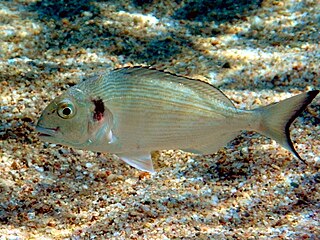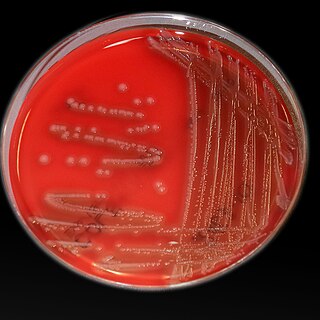
Vibrio is a genus of Gram-negative bacteria, possessing a curved-rod (comma) shape, several species of which can cause foodborne infection, usually associated with eating undercooked seafood. Being highly salt tolerant and unable to survive in fresh water, Vibrio spp. are commonly found in various salt water environments. Vibrio spp. are facultative anaerobes that test positive for oxidase and do not form spores. All members of the genus are motile. They are able to have polar or lateral flagellum with or without sheaths. Vibrio species typically possess two chromosomes, which is unusual for bacteria. Each chromosome has a distinct and independent origin of replication, and are conserved together over time in the genus. Recent phylogenies have been constructed based on a suite of genes.

The cobia is a species of carangiform marine fish, the only extant representative of the genus Rachycentron and the family Rachycentridae. Its other common names include black kingfish, black salmon, ling, lemonfish, crabeater, prodigal son, codfish, and black bonito.

Burkholderia is a genus of Pseudomonadota whose pathogenic members include the Burkholderia cepacia complex, which attacks humans and Burkholderia mallei, responsible for glanders, a disease that occurs mostly in horses and related animals; Burkholderia pseudomallei, causative agent of melioidosis; and Burkholderia cepacia, an important pathogen of pulmonary infections in people with cystic fibrosis (CF). Burkholderia species is also found in marine environments. S.I. Paul et al. (2021) isolated and characterized Burkholderia cepacia from marine sponges of the Saint Martin's Island of the Bay of Bengal, Bangladesh.

Burkholderia cepacia complex (BCC) is a species complex consisting of Burkholderia cepacia and at least 20 different biochemically similar species of Gram-negative bacteria. They are catalase-producing and lactose-nonfermenting. Members of BCC are opportunistic human pathogens that most often cause pneumonia in immunocompromised individuals with underlying lung disease. Patients with sickle-cell haemoglobinopathies are also at risk. The species complex also attacks young onion and tobacco plants, and displays a remarkable ability to digest oil.

Aeromonas hydrophila is a heterotrophic, Gram-negative, rod-shaped bacterium mainly found in areas with a warm climate. This bacterium can be found in fresh or brackish water. It can survive in aerobic and anaerobic environments, and can digest materials such as gelatin and hemoglobin. A. hydrophila was isolated from humans and animals in the 1950s. It is the best known of the species of Aeromonas. It is resistant to most common antibiotics and cold temperatures and is oxidase- and indole-positive. Aeromonas hydrophila also has a symbiotic relationship as gut flora inside of certain leeches, such as Hirudo medicinalis.
Photobacterium damselaesubsp.piscicida is a gram-negative rod-shaped bacterium that causes disease in fish.

Viral hemorrhagic septicemia (VHS) is a deadly infectious fish disease caused by Viral hemorrhagic septicemia virus. It afflicts over 50 species of freshwater and marine fish in several parts of the Northern Hemisphere. Different strains of the virus occur in different regions, and affect different species. There are no signs that the disease affects human health. VHS is also known as Egtved disease, and the virus as Egtved virus.
Enteric redmouth disease, or simply redmouth disease is a bacterial infection of freshwater and marine fish caused by the pathogen Yersinia ruckeri. It is primarily found in rainbow trout and other cultured salmonids. The disease is characterized by subcutaneous hemorrhaging of the mouth, fins, and eyes. It is most commonly seen in fish farms with poor water quality. Redmouth disease was first discovered in Idaho rainbow trout in the 1950s. The disease does not infect humans.

The gilt-head bream, also known as the gilthead, gilt-head seabream or silver seabream, is a species of marine ray-finned fish belonging to the family Sparidae, the seabreams or porgies. This fish is found in the Eastern Atlantic and the Mediterranean. It is a highly esteemed food fish and an important species in aquaculture.
Vibrio natriegens is a Gram-negative marine bacterium. It was first isolated from salt marsh mud. It is a salt-loving organism (halophile) requiring about 2% NaCl for growth. It reacts well to the presence of sodium ions which appear to stimulate growth in Vibrio species, to stabilise the cell membrane, and to affect sodium-dependent transport and mobility. Under optimum conditions, and all nutrients provided, the doubling time of V. natriegens can be less than 10 minutes. V. natriegens is able to successfully live and rapidly divide in its coastal areas due its large range of metabolic fuel. Recent research has displayed that Vibrio natriegens has a flexible metabolism, which allows it to consume a large variety of carbon substrates, reduce nitrates, and even fix nitrogen from the atmosphere under nitrogen-limiting and anaerobic conditions. In the laboratory, the growth medium can be easily changed, thus affecting the growth rate of a culture. V. natriegens is commonly found in estuarine mud.
Vibrio alginolyticus is a Gram-negative marine bacterium. It is medically important since it causes otitis and wound infection. It is also present in the bodies of animals such as pufferfish, where it is responsible for the production of the potent neurotoxin, tetrodotoxin.

Streptococcus iniae is a species of Gram-positive, sphere-shaped bacterium belonging to the genus Streptococcus. Since its isolation from an Amazon freshwater dolphin in the 1970s, S. iniae has emerged as a leading fish pathogen in aquaculture operations worldwide, resulting in over US$100M in annual losses. Since its discovery, S. iniae infections have been reported in at least 27 species of cultured or wild fish from around the world. Freshwater and saltwater fish including tilapia, red drum, hybrid striped bass, and rainbow trout are among those susceptible to infection by S. iniae. Infections in fish manifest as meningoencephalitis, skin lesions, and septicemia.
Edwardsiella tarda is a member of the family Hafniaceae. The bacterium is a facultatively anaerobic, small, motile, gram negative, straight rod with flagella. Infection causes Edwardsiella septicemia in channel catfish, eels, and flounder. Edwardsiella tarda is also found in largemouth bass and freshwater species such as rainbow trout. It is a zoonosis and can infect a variety of animals including fish, amphibians, reptiles, and mammals. Edwardsiella tarda has also been the cause of periodic infections for various animals within zoos. E. tarda has a worldwide distribution and can be found in pond water, mud, and the intestine of fish and other marine animals. It is spread by carrier animal feces.
Providencia rettgeri, is a Gram negative bacterium that is commonly found in both water and land environments. P. rettgeri is in the genus Providencia, along with Providencia stuartii, Providencia alcalifaciens, and Providencia rustigianii. P. rettgeri can be incubated at 37 °C in nutrient agar or nutrient broth. It was first discovered in 1904 after a waterfowl epidemic. Strains of the species have also been isolated from nematodes of the genus Heterorhabditis. Providencia rettgeri also found in marine environment.
Tenacibaculum is a Gram-negative and motile bacterial genus from the family of Flavobacteriaceae.

Sparicotyle chrysophrii is a species of monogenean, parasitic on the gills of the marine fish. It belongs to the family Microcotylidae. Its type-host is the gilt-head seabream.

Enteromyxum leei is a species of myxozoan, histozoic parasite that infects the intestinal tract and sometimes associated organs, like gall bladder and liver, of several teleostean fish species. Myxozoans are microscopic metazoans, with an obligate parasitic life-style. The parasite stages of this species live in the paracelullar space between fish enterocytes. It is the causative agent of enteromyxosis, or emaciative disease, also known as "razor blade syndrome" in sparid fish. E. leei has a wide host and geographical range within marine fish, and even freshwater fish have been infected experimentally. E. leei initially emerged in the Mediterranean in the late 1980s and it is believed to have been unintentionally introduced into the Red Sea. Its pathogenicity and economic impact depend on the host species. In the gilt-head seabream, it is manifested as a chronic disease that provokes anorexia, delayed growth with weight loss, cachexia, reduced marketability and increased mortality. In other species, it has no clinical signs. In sharpsnout seabream, infection results in very high mortality rates, which have pushed fish farmers to abandon the culture of this fish species.
Photobacterium ganghwense is a gram-negative, oxidase and catalase positive, motile bacteria of the genus Photobacterium. Photobacterium ganghwense are found in marine environment. S.I. Paul et al. (2021) isolated, characterized and identified Photobacterium ganghwense from marine sponges of the Saint Martin's Island Area of the Bay of Bengal, Bangladesh.
Photobacterium marinum is a gram-negative, oxidase and catalase positive, motile bacteria of the genus Photobacterium. Photobacterium marinum are commonly found in marine environment. S.I. Paul et al. (2021) isolated, characterized and identified Photobacterium marinum from marine sponges of the Saint Martin's Island Area of the Bay of Bengal, Bangladesh.

Photobacterium damselae subsp. damselae is a halophilic gram-negative rod-shaped bacterium. Commonly found in marine environments, P.d. subsp. damselae can cause disease in many species marine wildlife and is an emerging threat in aquaculture. In humans Photobacterium damselae subsp. damselae can cause severe infections.The type strain of Photobacterium damselae subsp damselae is ATCC 33539T.
Hilgarth, Maik et al. “Photobacterium Carnosum Sp. Nov., Isolated from Spoiled Modified Atmosphere Packaged Poultry Meat.” Systematic and Applied Microbiology 41.1 (2018): 44–50.










